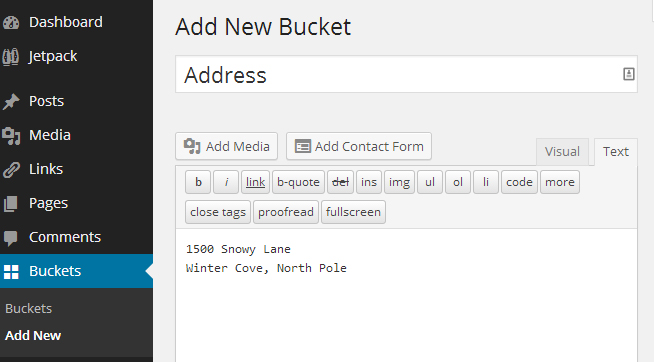
Buckets is a plugin that has been providing an alternative to WordPress widgets for the past two years. Created by plugin developer Matthew Restorff, Buckets allows you to create reusable pieces of content and place them anywhere on your WordPress site.
When describing his motivation for creating Buckets, Restorff says that the plugin was meant from the beginning to be an alternative to widgets. “I was tired of the pitfalls of standard WordPress widgets,” he said. “[pullquote]I wanted a way of creating reusable content that offered more control for the developer and better ease of use for the client.[/pullquote]”
Buckets turned out to be much easier for his clients to use, compared to widgets. Here’s a quick walkthrough of how it works:
Once installed, Buckets has its own menu where you can go to create new content:
This looks and works just like the WordPress post editor. Create some content and click ‘Publish’. When you navigate back to your list of Buckets, it will show you a shortcode for each.
[bucket id="946" title="Address"]
You can then paste the shortcode wherever you want the content to appear. It works inside posts, pages, custom post types, widgets and even inside another bucket. With the latest version, you don’t even need to know the shortcode, because buckets can be inserted into content using a button in the TinyMCE editor.
Buckets become even more powerful when paired with the Advanced Custom Fields plugin. This plugin allows you to create your own sidebars and add new fields to further customize your Buckets, thereby making WordPress fully modular. It is required in order to make use of some of Bucket’s more advanced functionality.
How are Buckets different from widgets?
 Buckets are very similar to widgets but with a few important distinctions that make them more flexible:
Buckets are very similar to widgets but with a few important distinctions that make them more flexible:
- Designed to create content that is easy to reuse in multiple places
- Bucket creation includes ability to use the visual editor and media manager
- Content can be used anywhere, not limited to widgetized areas
Recent Major Improvements to Buckets
I caught up with Matthew Restorff to find out what kinds of improvements he’s added to the plugin recently. Here are a few of the highlights:
- Button added to the TinyMCE so users can now insert buckets into their content without shortcodes
- Buckets listing page now displays the pages where you have placed buckets
- On page editing/adding so you can edit your entire page’s content without leaving the page
Many of the changes to the plugin have come directly from feedback provided by Restorff’s clients. He continues to maintain the plugin, because it helps his clients to be more independent. “I’m a huge advocate of making things easier on the client so they can keep their sites up to date,” he said. “[pullquote]I love the idea of someone with not much experience being able to maintain a really robust website.[/pullquote]”
A New Way of Looking at WordPress Content Management
I am intrigued by the idea of Buckets, because it provides a new way of looking at WordPress. Traditionally, we let themes dictate the widgetized areas where the user can easily drop in dynamic pieces of content. With Buckets and Advanced Custom Fields working together, you wouldn’t need sidebars or widgets at all, in theory, although they do help to keep a design more uniform. Buckets gives you full control of where you want content to be placed. You’re not limited by what your theme offers you in terms of sidebars.
If widgets just aren’t flexible enough for you, or if they prove to be too confusing for your clients, consider giving Buckets a try. If you install this plugin, you’ll still be able to use your widgets in addition to Buckets. The two do not conflict. Buckets has received all 5-star reviews on WordPress.org so far. Documentation for the plugin can be found in this Google doc.

Very interesting. Thanks for the write up, I’ll be keeping and eye on this :)